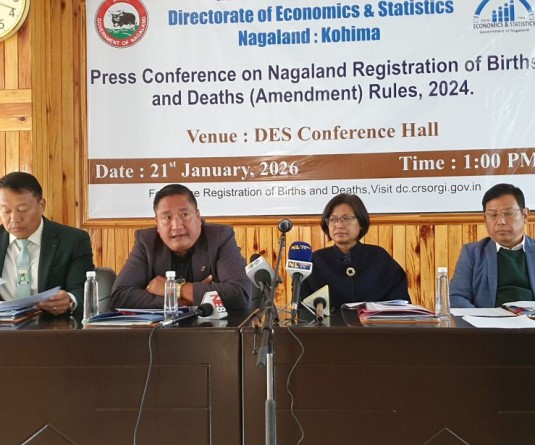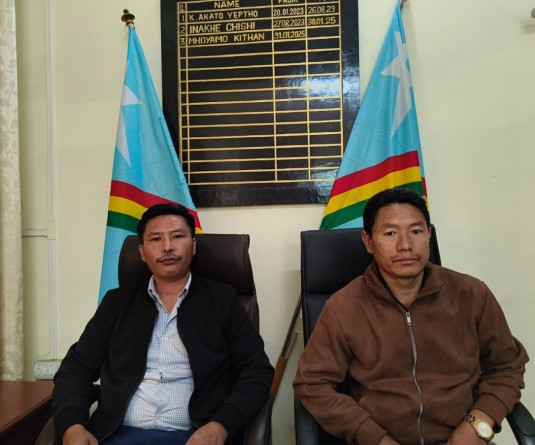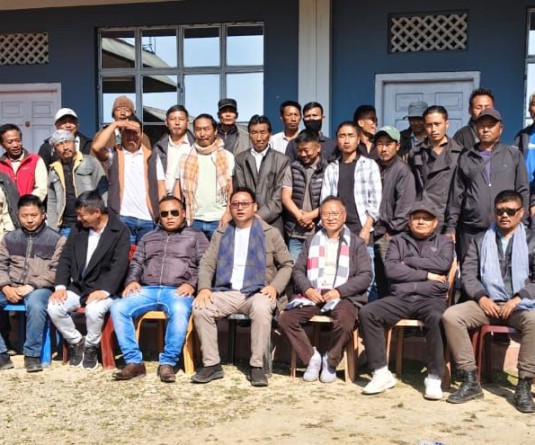Photo Courtesy: kohimahighcourt.gov.in

Directs Nagaland State govt to ‘immediately’ grant a batch of RMSA teachers higher pay scale
Morung Express News
Kohima | March 18
In a significant judgment, the Gauhati High Court Kohima Bench, while upholding the doctrine of ‘equal pay for equal work,’ has directed the Nagaland State Government to pay salaries to a batch of teachers employed under the Rashtriya Madhyamik Shiksha Abhiyan (RMSA) in parity with their counterparts.
The law is also well settled that the doctrine of “equal pay for equal work” as enshrined under Article 39 (d) of the Constitution of India read with Article 14 and this can be applied for those “who are equally placed in all respect,” observed Justice Devashis Baruah and Justice Arun Dev Choudhury on March 16.
Background of the case
On December 2013, an advertisement was floated for recruitment of 951 teachers and sports instructors under the RMSA, while a notification in October 2015 accorded sanction for creation of 627 posts of Graduate Teachers in the Pay Band of Rs 9300-34,800 with Grade Pay of Rs 4200 per month.
After the recruitment process, 528 candidates were selected and accordingly, the petitioners were appointed in a fix pay of Rs 32,315 in November 2015, while another 111 were appointed under the same terms and conditions in May 2016.
At the time of appointment, the petitioners signed a bond declaring that the posts were purely on contractual basis “with monthly salary of Rs. 31,315 per month.”
Meanwhile, the then Union Ministry of Human Resources Development took a decision to merge the Sarva Shiksha Abhiyan (SSA), RMSA and TE teachers into one entity called “Samagra Shiksha” with effect from April 3, 2018.
The Director, Department of School Education and Literacy, MHRD, on April 5, thereafter, forwarded the draft framework to all the States stipulating that the of salaries of teachers for Secondary Schools were fixed at Rs 25,000 per month.
Consequently, in an Office Memorandum (OM) issued on August 17, 2018, the petitioners were directed to accept reduced salaries the while another issued the next day directed them to accept the same within a month.
Another notification on August 27, 2018 ‘threatened’ the petitioners with action under the Nagaland Servants Rules 1968 on failure to comply with earlier notices.
The RMSA teachers subsequently petitioned the High Court against the notifications. In May 2020, the notifications were set aside, while the court rejected the petitioners’ appeal for a direction to the government to provide them their post creation pay band.
The current case
On March 16, the Court heard an appeal filed by the RMSA teachers against the judgment. The Court observed that the State has not appealed against the earlier judgment of May 5, 2020 and it only dwelt on whether the petitioners are entitled to the original pay band and whether the Single Judge “committed error while declining the aforesaid prayer of the petitioner.”
As per the Court’s order, the petitioners contended that prior to their appointment and selection, the State Government by notification on November 28, 2015, sanctioned the posts with the aforesaid scale of pay.
Further, they argued that all other appointments of teachers under SSA and RMSA, prior and subsequent to their appointments, were also preceded by similar sanction and “are being paid the said scale of pay.”
Meanwhile, the State Cabinet on November 3, 2018, merged all the teachers appointed in SSA and RMSA into one entity called the “Samagra Shiksha” and via an OM on November 5, merged those teachers as State cadres except the petitioners.
“Being similarly situated with the other teachers of SSA and RMSA, two groups could not have been created by the respondent State,” the petitioners argued.
As per the Court, the State respondents took the stand that the notification on November 18, 2015 sanctioning for creation of temporary posts and appointment of the petitioners itself stipulated that the “terms and condition of appointment shall be made in the appointment order and the State Government will not be responsible for their salaries including future service.”
As such, the state respondent, contended that the petitioners cannot claim the scales of pay stipulated in the November 28, 2015, notification as a matter of right.
The State respondents further maintained that the other teachers with whom the petitioners are claiming parity were appointed through separate advertisement by the Education Department. Others issues were not disputed.
Why parity?
Based on the arguments, the Court noted that the petitioners and similarly situated teachers appointed in SSA and RMSA perform the same duties.
Accordingly, the Court noted that the law is well settled that “equal pay for equal work is a concept which can be applied when the identity between a group of employees claiming identical pay scale and another group who have already earned such pay scale should be complete and wholesome.”
“Parity can be claimed when the eligibility, mode of selection, nature and quality of work and duties of effort, functional need and responsibilities and status of both the posts are identical,” it elaborated, while adding that it depends on the “comparative evaluation of job and equation of posts.”
In the present case, a comparative evaluation makes its absolutely clear that the petitioners are having similar qualifications, posted and appointed in similar schools managed by the State authorities and the students they teach are similar.
“Therefore, it will not be permissible for the State respondents to treat the two classes of teachers differently so far relating to their scales of pay.”
Apex Court’s ruling
To this end, the Court further relied on Supreme Court judgment (State of Punjab and Others –vs- Jagjit Singh and Others, 2017) in which it held that “…it is fallacious to determine artificial parameters to deny fruits of labour. An employee engaged for the same work cannot be paid less than another who performs the same duties and responsibilities.”
Calling such action demeaning and strikes at the very foundation of human dignity, the Apex Court then has noted that “anyone, who is compelled to work at a lesser wage does not do so voluntarily” but to “provide food and shelter” to their families at the cost of self-respect and dignity, self-worth, and integrity.
“Any act of paying less wages as compared to others similarly situate constitutes an act of exploitative enslavement, emerging out of a domineering position,” it added, terming the action as “oppressive, suppressive and coercive, as it compels involuntary subjugation.”
Accordingly, the High Court Bench in its order said that the Single Judge’s earlier decision failed to appreciate the fact that the petitioners and their counterparts are “equally placed and there is wholesome equality between them.”
Accordingly, the Bench stated the petitioners are entitled for scales of pay as pleaded and directed the State respondents to “grant such scales of pay to the petitioners forthwith.”
It further made clear that it was not determining whether the other teachers, excluding the petitioners, were brought under State cadre with benefit including NPS, as it was not challenged in the writ petition.






